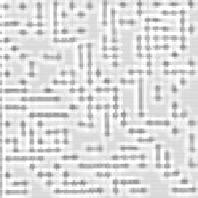Information Technology Reference
In-Depth Information
(a) (b) (c)
Fig. 8.14.
Contributions to the activity of the hidden feature from Fig. 8.13(b) (bright shading
represents inhibition, dark shading represents excitation): (a) via input projections; (b) via
lateral projections; (c) via backward projections.
10000
4500
TRN
TST
TRN
TST
4000
3500
1000
3000
2500
2000
100
1500
1000
500
10
0
0
2
4
6
8
10
12
14
16
18
20
0
2
4
6
8
10
12
14
16
18
20
(a)
(b)
iteration
iteration
Fig. 8.15.
Recall of iterative Data Matrix binarization over time: (a) average squared output
change; (b) average squared output difference to desired output.
After analyzing the network's behavior for a single example, its performance for
all examples of the high-contrast dataset is measured. Figure 8.15(a) displays the
average squared output change over time. In the first iterations, the output changes
considerably. The changes decrease quickly until iteration 10 and remain low after-
wards. Thus, the network dynamics is stable even when iterating twice as long as
it was trained for. The small average changes at higher iterations indicate that the
network converges to an attractor for almost every example.
In Figure 8.15(b) the average squared difference to the desired output is shown
over time. One can observe that the average error decreases rapidly during the first
iterations. It reaches a minimum at about iteration 8 and increases again slowly.
Hence, the network's attractors are not identical to the desired outputs.
This is not surprising since the network was trained to produce the desired out-
put only for ten iterations. When iterated further, the dynamics evolves into stable
attractors that resemble the cell structure of the Data Matrix codes. This cell struc-
ture was not used to produce the desired outputs. In contrast, the desired outputs
were computed by a pixel-based adaptive thresholding, as described in Section 8.3.
The desired outputs are not necessarily the ideal outputs but only approxima-
tions to the best recognizable ones. Thus, a deviation from the desired outputs does
not necessarily indicate a decrease in output quality, as measured in recognition















































































































Search WWH ::

Custom Search